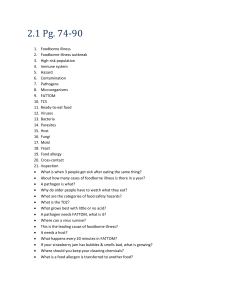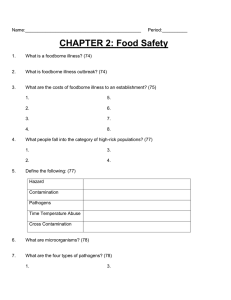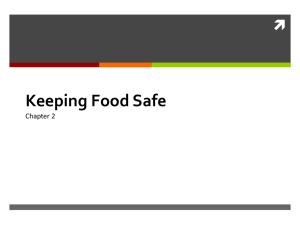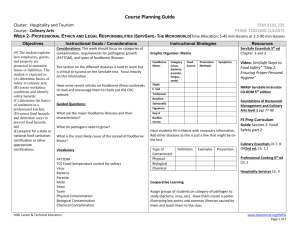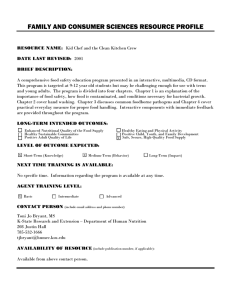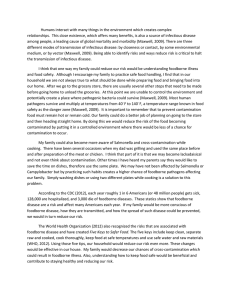The Economics of Food Safety and International Trade in Food Products
advertisement
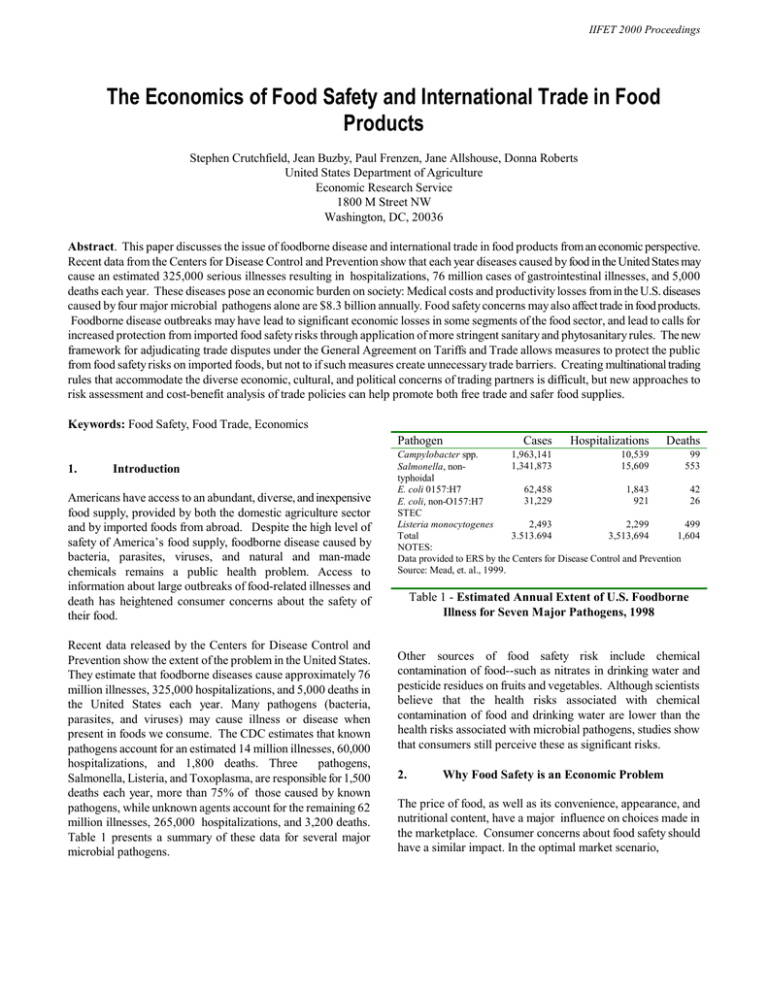
IIFET 2000 Proceedings The Economics of Food Safety and International Trade in Food Products Stephen Crutchfield, Jean Buzby, Paul Frenzen, Jane Allshouse, Donna Roberts United States Department of Agriculture Economic Research Service 1800 M Street NW Washington, DC, 20036 Abstract. This paper discusses the issue of foodborne disease and international trade in food products from an economic perspective. Recent data from the Centers for Disease Control and Prevention show that each year diseases caused by food in the United States may cause an estimated 325,000 serious illnesses resulting in hospitalizations, 76 million cases of gastrointestinal illnesses, and 5,000 deaths each year. These diseases pose an economic burden on society: Medical costs and productivity losses from in the U.S. diseases caused by four major microbial pathogens alone are $8.3 billion annually. Food safety concerns may also affect trade in food products. Foodborne disease outbreaks may have lead to significant economic losses in some segments of the food sector, and lead to calls for increased protection from imported food safety risks through application of more stringent sanitary and phytosanitary rules. The new framework for adjudicating trade disputes under the General Agreement on Tariffs and Trade allows measures to protect the public from food safety risks on imported foods, but not to if such measures create unnecessary trade barriers. Creating multinational trading rules that accommodate the diverse economic, cultural, and political concerns of trading partners is difficult, but new approaches to risk assessment and cost-benefit analysis of trade policies can help promote both free trade and safer food supplies. Keywords: Food Safety, Food Trade, Economics Pathogen 1. Introduction Americans have access to an abundant, diverse, and inexpensive food supply, provided by both the domestic agriculture sector and by imported foods from abroad. Despite the high level of safety of America’s food supply, foodborne disease caused by bacteria, parasites, viruses, and natural and man-made chemicals remains a public health problem. Access to information about large outbreaks of food-related illnesses and death has heightened consumer concerns about the safety of their food. Recent data released by the Centers for Disease Control and Prevention show the extent of the problem in the United States. They estimate that foodborne diseases cause approximately 76 million illnesses, 325,000 hospitalizations, and 5,000 deaths in the United States each year. Many pathogens (bacteria, parasites, and viruses) may cause illness or disease when present in foods we consume. The CDC estimates that known pathogens account for an estimated 14 million illnesses, 60,000 hospitalizations, and 1,800 deaths. Three pathogens, Salmonella, Listeria, and Toxoplasma, are responsible for 1,500 deaths each year, more than 75% of those caused by known pathogens, while unknown agents account for the remaining 62 million illnesses, 265,000 hospitalizations, and 3,200 deaths. Table 1 presents a summary of these data for several major microbial pathogens. Cases Hospitalizations Deaths 1,963,141 10,539 99 Campylobacter spp. 1,341,873 15,609 553 Salmonella, nontyphoidal 62,458 1,843 42 E. coli 0157:H7 31,229 921 26 E. coli, non-O157:H7 STEC 2,493 2,299 499 Listeria monocytogenes Total 3.513.694 3,513,694 1,604 NOTES: Data provided to ERS by the Centers for Disease Control and Prevention Source: Mead, et. al., 1999. Table 1 - Estimated Annual Extent of U.S. Foodborne Illness for Seven Major Pathogens, 1998 Other sources of food safety risk include chemical contamination of food--such as nitrates in drinking water and pesticide residues on fruits and vegetables. Although scientists believe that the health risks associated with chemical contamination of food and drinking water are lower than the health risks associated with microbial pathogens, studies show that consumers still perceive these as significant risks. 2. Why Food Safety is an Economic Problem The price of food, as well as its convenience, appearance, and nutritional content, have a major influence on choices made in the marketplace. Consumer concerns about food safety should have a similar impact. In the optimal market scenario, IIFET 2000 Proceedings consumers make their purchase decisions possessed of a full and correct understanding about how their selections will affect their well-being, but unlike most other product characteristics, food safety is usually not discernible to consumers at the time of purchase. Therefore, consumer ignorance of the safety of their food purchases limits the degree to which demand for safer food can lead the market to enhance food safety. 2.1 Measuring Food-Safety Costs Two approaches have been used to measure the costs of foodborne illness. The first is the “Cost-of-Illness” (COI) approach, which measures the sum of medical expenses and lost productivity due to illness or death. Basically, this approach measures the cost of unsafe food as the costs of treating foodborne diseases plus lost productivity when victims can’t work. Currently, the market provides few incentives for producers to provide levels of food safety beyond those mandated by government regulations or to offer the public other than the most rudimentary information about the safety of their food product. The cost of having products linked to outbreaks of food borne illness, both to reputation and sales, does provide some incentive for producers to ensure the safety of their products. However, the complexity of the process whereby food travels from farm to table makes warranting food safety risky business for producers. The liability associated with claims of 100% safety, if proven false, is a significant disincentive for producers to advertise their food as “safe.” Constrained from advertising "safe" food and thus reaping market rewards, producers have no vested interest in making information about the safety of their food product more available to consumers. The advantage of the COI approach is that it employs available data that are fairly reliable and consistent over time. Because the concepts are both easy to understand and data are obtainable from market transactions, COI measures have been widely used for several decades. Consumer pressure necessary to impact the market in the matter of food safety will not occur until the information gap is closed. Until then, an optimal level of food safety is not likely to be achieved within a non-regulated market. This lack of consumers’ food safety information and the lack of producers’ incentives to provide it leads to market failure The COI approach seems to be crudely “economic” in the sense that it values lost income and the associated consumption expenditures; but in fact the approach does not conform with economic theory because it fails to recognize the value that individuals may place on (and be willing to pay for) feeling healthy, avoiding pain, or using their free time. Because the COI approach explicitly ignores these valuable aspects of health, the method is generally thought to understate the true societal benefits from risk reduction. This method places a lower value on reducing risks of the elderly because they have low future earnings to forego. Also, this method attaches a rather low value to risk reduction for children, depending on the discount rate used to value future earnings of children to the present. It would be impossible to provide a risk-free food supply. Since there are costs associated with increasing food safety, society must decide how much, if any, it is willing to spend on food safety and where these dollars will have the greatest impact. The optimum level for food safety would be where the marginal cost of creating one more unit of food safety equals its marginal benefit. The Department of Agriculture (USDA) has estimated the COI for seven pathogens which are found on some meat and poultry. These estimates are calculated from the number of annual foodborne-illness cases and deaths; the number of cases that develop secondary complications; and the corresponding medical costs, lost productivity costs, and other illness-specific costs. The marginal costs would be the costs to food processing plants to meet new food safety plans and the cost of government programs aimed at educating consumers, retailers, and foodservice workers about safe food handling. The marginal benefits are the reduced illness and mortality associated with a safer food supply. However, since these benefits or goods are not traded in the market, how do you assign them a dollar value? Establishing incidence rates for foodborne illness was challenging due in large part to the nature of the illnesses. Many individuals do not recognize food as the cause of their illness and often even when they do, they do not consult a physician. Finally, physicians do not always recognize the illness as foodborne. As a result the number of cases of foodborne disease is vastly underreported. In the next section of this paper, we show how economists have measured the costs of unsafe food. This gives us a benchmark by which to measure the benefits of programs and policies that improve food safety - the benefits being the reductions in costs associated with unsafe food. Once the incidence rate was established medical costs were calculated. Included here were the cost of doctors, hospitals, medicines, and supplies. Productivity losses were calculated for time lost from work using a daily wage rate times the amount of time lost from work as a proxy for the value of lost output. Productivity losses were also calculated for those unable to return to work or who died. 2 IIFET 2000 Proceedings (USDA/ERS, unpublished estimates). Previous studies (Buzby, et. al, 1996) have shown that this approach raises the cost estimates considerably. All told, the cost of foodborne illnesses and deaths related to the five pathogens studied is $8.3 billion, annually. Using this method, the total cost of foodborne disease from four pathogens presented in Table 1 (E. coli O157:H7, Salmonella, Campylobacter, and Listeria monocytogenes) was between $1.2 to $6.4 billion annually (Buzby, et. al.). (It should be noted here that these estimates are based on number of cases and deaths reported in 1996, not the latest figures cited in Table 1.) Pathogen Costs ($ billion, 1998) 2.4 Campylobacter, spp. 2.2 Salmonella, non-typhoidal 0.7 E. coli 0157:H7 0.4 E. coli, non-O157:H7 STEC 2.6 Listeria monocytogenes Total 8.3 NOTES: The total estimated costs include specific chronic complications in the case of Campylobacter (Guillain-Barré syndrome), E. coli O157:H7 (Hemolytic uremic syndrome), and Listeria monocytogenes (congenital and newborn infections resulting in chronic disability or impairment). Estimated costs for Listeria monocytogenes exclude less severe cases not requiring hospitalization Table 2 - Estimated Annual Costs Due to Selected Foodborne Pathogens, 1998 The issue of how to place premature deaths in an economic context is a difficult challenge for economists. Essentially, we are asked to respond to the question of “What is a life worth?” Two approaches are commonly used. The first approach says that one measure of the economic value of an individual is the amount of income he/she earns over his/her lifetime. In other words, one measure of the costs of a premature death from foodborne disease is the current dollar value of all future income that individual would have earned had he/she not died. This is called the “Human Capital” approach to valuing premature deaths, as developed by Landefeld and Seskin (1982). Another approach economists have used is to look at the way individuals reveal their attitudes toward risky activities through their behavior. For example, some individuals choose to take jobs which have an increased risk of death or injury in return for higher wages, such as building skyscrapers, fishing in the arctic waters off Alaska, and so forth. In principle, the value placed on an increased risk of premature death in those cases can be equated with the extra wages paid to workers to induce them to voluntarily undertake these risk. Viscusi (1993) analyzed labor market data for twenty-four high-paying, risky occupations, and estimated the extra wages paid to such workers. He found that, when pooled over a large numbers of individuals with various risks of job-related premature death, between $3 and $7 million would be paid to raise the aggregate risk of death in the labor market by one. That is, to induce enough workers to undertake risky jobs with a probability of one extra death, the extra wages paid to those workers would be between $3 and $7 million (in 1990 dollars). 2.2 Why Economics Matters These estimates of the social costs of foodborne illness, while revealing of the total burden these illnesses place on society, are only a starting point. Economists also are interested in how efforts to prevent foodborne illness can reduce this burden, and the relationships between the benefits of safer food and the costs of achieving this goal. Ideally, we would want to chose to implement regulations and other efforts to control foodborne disease only when/if the costs of pathogen reduction are less than the benefits of reduced medical costs and productivity losses. In response to increasing concerns about food safety, the United States (along with other nations) have taken steps to improve the safety of their food supplies. These steps can be in the form of regulations designed to change firm behavior, creation of economic incentives through tax or fiscal policy for firms to reduce food safety risks, educational campaigns to promote consumer awareness and adoption of safer food handling practices, or some combination of all of these approaches. In some economic analysis, then, this estimate has been used to place a dollar value on premature deaths. The Consumer Product Safety Commission uses Viscusi’s range and/or a $5million estimate per life lost in its analysis; the Environmental Protection Agency (EPA) uses Viscusi’s range in estimating the benefits of the Clean Air Act; and FDA used $5 million in its evaluation of new seafood inspection systems. Buzby et. al. (1996) used the midpoint of Viscusi’s range of values to place a $5 million cost on each premature death from foodborne diseases. In later analyses, economists at the USDA’s Economic Research Service used a different approach. ERS modified the labor market approach by taking the age distribution of deaths from each pathogen into account, in effect treating the value of life as an annuity paid over the average U.S. life span at an interest rate of 3.0 percent. Following ageadjustment, the assumed cost of each death ranges from $8.4 million for individuals who died before their first birthday to $1.6 million for individuals who died at age 85 or older. Regulations, by definition, will change the costs of producing food – if one assumes that private firms are already operating at minimum cost in the absence of regulations. Some of these costs may be passed on to consumers in the form of higher prices, some of these costs may be borne by firms in the form of lower profits, and some may be passed back to farmers. The role of economics is to measure how large these costs may be, and to determine who bears the costs. The costs, in turn, are then compared to the benefits of improving food safety. To be considered justifiable from an economic perspective, the costs of 3 IIFET 2000 Proceedings achieving food safety goals (whichever approach is taken) should be less than the benefits of improved public health. The benefits of reducing food-safety risk are the reductions in medical costs, productivity losses, and costs of premature death that derive from programs and policies designed to reduce that risk. To an economist, the programs to achieve this risk reduction are desirable if these benefits are greater than the costs. Source As an example, Crutchfield et. al. (1997) recently conducted an analysis of the United States Department of Agriculture’s Hazard Analysis and Critical Control Points (“HACCP”) Pathogen Reduction Rule. The Rule requires food processors to identify food safety hazards and to develop interventions to reduce or eliminate these hazards. In their study, Crutchfield et. al. evaluated the potential benefits of the new rules designed to reduce microbial pathogens in meat and poultry. They then compared these benefits to the costs of imposing the rule on slaughter and processing firms. They discovered that the benefits of the rule exceeded the costs of the regulation as long as the rule achieved at least a 17 percent reduction in foodborne illness. Red Meat 6.5 Fish/Shellfish 55.3 Eggs 0.1 Fresh Vegetables 11.7 Vegetable for Processing 2.3 Fresh Fruits 33.3 Source: USDA Economic Research Service Table 3 - Imports as source of US food supply 3.1 Food Safety Scares may Disrupt Food Markets and Trade In recent years some well-publicized incidents have led to increased public concern in the United States about exposure to potentially hazardous chemicals and pathogens in the imported food. Recent outbreaks of foodborne illness linked to imported foods have heightened this concern. For example, the past year has seen outbreaks of illness from Hepatitis A virus on imported strawberries and the Cyclospora microbe on imported raspberries. Abroad, we have seen the highly-publicized “Mad Cow Disease” outbreak in the United Kingdom, and outbreaks of E coli O157:H7 in Asia. Economics can also be useful in setting priorities for further research and interventions to prevent foodborne illness, whether from domestic or imported foods. For example, some pathogens may be more widespread or cause more illnesses than others, but may impose less of a burden on society because the illnesses they cause are less severe or may result in fewer premature deaths. Several agencies within the U.S. government are currently undertaking a research effort to rank the various sources of foodborne disease on the basis of the economic costs of those diseases. This will help set priorities for allocation prevention and control efforts across the various sources of foodborne disease, domestic or imported. 3. Percent of U.S. consumption Outbreaks of foodborne disease linked to imported foods can severely disrupt food markets, causing economic losses for the food sector. The British beef market and trade in U.K. beef products was severely impacted by the recent outbreak of “Mad Cow Disease.” An outbreak of E. coli O157:H7 in Japan may have caused U.S. exports of beef to that country to temporarily drop by as much as 40 percent. An extreme example from the past involved Chilean grapes in to the U.S. Traces of cyanide were found on two grapes tested, and in response trade in this product was temporarily halted. Concern has been raised by some in the U.S. about a “cycle of poison;” where pesticides no longer approved for use in the U.S. reenter the domestic market as residues on imported produce. Food Safety and International Trade The world market for food is becoming increasingly global in scope. Trade in food products is increasing, particularly for minimally processed foods. Imports provide a significant source of supply for many foods in the United States, particularly fish, shellfish, and fresh fruits and vegetables (see Table 3). While consumers benefit from an increase in the variety of food choices available, concern remains that imported food may pose a safety risk. In some respect, concern about the safety of imported food products may be higher than necessary. Scientists and regulatory personnel generally view contamination by microbial bacteria and naturally occurring toxins as greater dangers to human health than pesticide residues. Compared with animal products (where a relatively small percentage of U.S. supply is imported), in relatively few instances has fresh produce been identified as a vehicle for carrying disease causing pathogens. A recent study by Zepp, et. al. (1998) found no definitive evidence that health risks due to either pesticide residues or microbial contamination are greater for imported produce than for domestic produce. Food safety concerns can have an economic effect in international trade markets in a number of ways. Two of the most prominent are the potential for outbreaks of foodborne disease linked to imported foods to disrupt international markets for food products, and the potential for food safety concerns to lead to trade barriers through adoption of protective sanitary and phytosanitary regulations. We conclude this paper by discussing these two issues from an economic perspective. 4 IIFET 2000 Proceedings All these considerations together provide an explanation for continued consumer concern about food safety risk and demand for risk reduction. The risks are involuntary in nature, they are subject to considerable uncertainty, they may result in potentially disastrous outcomes (cancer, disability and death), at a small but non-zero probability, and they tend to disproportionately affect those for whom society has an expressed preference for risk protection. For these reasons, public concern has in the past led to demands for protective sanitary and phytosanitary standards to protect the public from perceived (albeit uncertain) food safety risk. Still, public concern in the U.S. remains about the safety of imported foods. There are several reasons why consumer concern about food safety may be greater than indicated by dispassionate, scientific risk assessments. One reason for continuing consumer concern about foodborne health risks is that the health risk are not easily discernable. Unlike some food quality problems (such as spoilage or cosmetic flaws), microbial and other food-safety risks cannot be easily detected when the product is purchased. Consumers are not able to determine whether their hamburger contains E. coli O157:H7, whether their chicken contains Salmonella, or whether pesticide residues or potentially dangerous viruses are in their fruits and vegetables. So far, testing for microbial or chemical contaminants has proved too slow and expensive to become a routine part of the food distribution system. Testing identifies some problems, but largely serves to describe the extent of the problems rather than serve as an effective filter. Accordingly, consumers are not able to make informed decisions about their food consumption and possible health risks, and any risk that are imposed on them are involuntary in nature. In short, the risks are involuntary. Experience and empirical evidence suggests that consumer preferences for protection from risks of any sort, be they foodborne or otherwise, rises when the risks are involuntary in nature and not under the control of the individual. 3.2 Food Safety and International Trade Policies Extensive and increasing international agricultural trade (from $385.4 billion in 1992 to $463.5 billion in 1997) distributes more diverse foods of varying quality to wider markets. Any unsafe imported food can impose health costs on society, but consumers benefit from increased trade through lower prices, year-round supplies, and greater variety and quality. Therefore, countries have incentives to weigh the benefits and costs of different mechanisms which promote the twin goals of food safety and trade benefits. Standards and regulations provide important mechanisms sure to affect food trade and safety in the 21st century. Here we hope to clarify many of the complex issues surrounding the adoption of standards and regulations of imported foods. Another factor to be considered in the considerable uncertainty about the level of public health risk from foodborne sources. Our understanding of the overall risk from foodborne disease is incomplete and subject to considerable uncertainty. Although CDC estimates presented earlier show millions of cases of foodborne illness, the majority of those estimated cases are from unknown sources. The best available evidence suggest that risks of cancer and neurological disease from dietary exposure to pesticides in the diet is very low for the typical adult, yet consumer concern about pesticide residues remains high. 3.3 Reasons for international differences in food safety measures The diverse food safety risks to human health include pesticide and veterinary drug residues, food additives, and foodborne pathogens. The magnitude and the causes of the risks vary among exporting and importing countries. Among exporting countries, risks vary due to international differences in food production practices (for example, use of veterinary drugs), geographic distribution of pathogens (some pathogens don’t survive in colder climates, for example), plant and livestock host factors (herds exhibit varying infection rates), and available technology (refrigeration, potable water, for example). Among importing countries, risks vary because of available technology, human host factors (proportion of population with greater susceptibility to these risks), and consumption patterns (for example, routine consumption of raw fish). Consumer concern is also heightened by the uncertainty about the eventual outcomes of exposure to foodborne health risks, and uncertainty about the effects of dietary exposure on particular sub-populations. While some foodborne illnesses may result in a mild case of gastrointestinal distress, others may results in severe disability of death. For example, exposure to the pathogen Campylobacter may result in a case of Guillian Barre syndrome, a paralytic disorder which can cause lifetime paralysis and death (Buzby, et. al, 1997). Any mention of the word "cancer" in a public health debate is bound to raise public concern, even if the risks of cancer are low and the eventual outcomes far into the future, so consumer fears about potentially cancer-causing chemicals in the food supply may be inflated beyond what scientific risk easement may imply. Cancer is particularly dreaded, and is sometimes viewed as an irreversible outcome. Also, many sub-groups in the population thought to be most at risk for foodborne health risks are those groups usually afforded the greatest concern and preference for health protection: infants, the elderly, and pregnant women. Even when risks vary little across countries, assessments of the risks may vary due to differences in access to and use of advances in basic science, detection technology, and mitigation methods. Several committees under the Codex Alimentarius Commission (Codex), such as the Codex Committee on Food Additives and Contaminants, disseminate scientific information on foodborne hazards and risk assessment methodology to narrow information gaps, paving the way for establishing international standards. But continual development of new 5 IIFET 2000 Proceedings agricultural inputs and products, together with regular advances in detection and eradication technology, outpace international efforts to establish a consensus on risks and mitigation methods. In the interim, some countries may refuse to allow imports of products (such as genetically-modified foods or irradiated meat) that have been approved for sale in others. Food safety attribute Countries may also choose different policy measures to manage similar risks. Income explains some variation, as consumers in wealthier countries may be willing to pay more for higher standards. Also, measures may in part reflect past food safety incidents such as low-probability, high-consequence events (for example, a botulism outbreak) that heighten consumer demand for stricter regulations. And, countries may choose to manage risks differently in response to consumer preferences for other food attributes (such as taste) besides safety (Henson and Traill). For example, many European countries use process standards to minimize the risks of Listeria in cheese made from unpasteurized milk, while the United States bans the sale of most of these cheeses. This complex mosaic of risks and risk mitigation measures creates substantial debate among scientists, disagreement among food safety regulators, and discord among trading partners. The impact of divergent food safety standards on trade is largely unknown, primarily because we lack systematic information on the measures themselves and we have underdeveloped methods of economic assessment. In one preliminary exploration, however, Roberts and DeRemer surveyed USDA’s foreign attachés and representatives from agricultural producer groups. They identified questionable technical trade barriers (traderestricting regulations that seem primarily aimed at shielding domestic producers from competition) and estimated the impacts on U.S. exports of agricultural products. Respondents identified 303 barriers in 62 countries that threatened, constrained, or blocked an estimated $5 billion of U.S. exports of agricultural, forestry, and fishery products (7 percent of the total) in 1996. Food safety barriers accounted for about onefourth of the number of restrictions, but about one-half of the estimated export revenue losses because they often restrict sales of high-value products such as processed foods and meats (Table 1). The survey identified other questionable technical barriers--primarily restrictions justified on the basis of protecting crops and herds. Number of barriers Estimated U.S. export revenue losses (percent) Foodborne pathogens 31 12 Food additives 13 45 Veterinary residues 12 8 Residues and pathogens 6 9 Multiple attributes (including genetically modified organisms) 5 24 Naturally occurring toxins 3 <1 Heavy metals 2 <1 Pesticide residues 1 <1 Total food safety 73 100 barriers Notes: “Barriers” are those that survey respondents judged to be primarily aimed at shielding domestic producers from international competition. Source: Roberts and DeRemer Table 4 - Profile of questionable food safety technical barriers to U.S. agricultural exports, 1996 . 3.4 Food safety measures in the multilateral trading system A framework for determining the legitimacy of questionable food safety measures emerged from the 1986-93 Uruguay Round of Multilateral Trade Negotiations in the Agreement on the Application of Sanitary and Phytosanitary Measures (SPS Agreement). SPS rules in the original (1947) General Agreement on Tariffs and Trade (GATT) allowed measures “necessary to protect human, animal or plant life and health” but stipulated that measures should not constitute disguised restrictions or create unnecessary trade barriers. Despite these rules, SPS regulations proliferated and began to disrupt trade. Uruguay Round negotiators therefore aimed to create more 6 IIFET 2000 Proceedings stringent rules, primarily by requiring that regulatory decisions be based on scientific risk assessments. Negotiators believed that this would encourage countries to adopt measures that balanced desirable benefits and undesirable risks of international trade, while discouraging measures designed simply to protect domestic markets. 3.5 Multilateral coordination mechanisms and private systems approaches Many countries have shown an increased interest in food safety issues, as seen by the United Kingdom’s efforts to create a single food safety agency, the series of new U.S. food safety initiatives, and regulatory reorganization efforts by Canada, New Zealand, and Australia. In response to cross-border spillovers, arbitrage pressures, and other trade-related tensions, countries are adopting multilateral coordination mechanisms such as mutual recognition, coordination, and harmonization (Sykes). Mutual recognition means a country explicitly accepts the standards, certification procedures, and regulations of other countries (for example. U.S. inspection of meat is accepted for their imports). Coordination takes convergence one step further by jointly designing adjustments to each countries’ policies (using, for example, WHO control procedures for communicable diseases). Harmonization entails even higher levels of convergence such as regional or world standards or agreements. However, greater coordination may add costs. For example, if a group of countries agrees to only trade foods that meet a particularly high standard, then imports not meeting these standards will not be available to consumers, reducing consumer choice. Creating multilateral rules that set parameters for food safety measures is a delicate challenge because of the trade-offs between commerce and human health risks. Some fear that the Agreement is intended to promote “downward harmonization” of national standards to facilitate trade. Recognizing these political concerns, negotiators agreed to endorse, rather than oblige, the adoption of international standards. Moreover, the Agreement does not stipulate restrictions on the economic costs that can factor into decisions to mitigate human health risks. This provides leeway for countries to adopt measures that achieve incremental risk reductions at exorbitant cost. The U.S. Statement of Administrative Action to Congress states that the Agreement “explicitly affirms the rights of each government to choose its levels of protection including a ‘zero risk’ level if it so chooses” (President of the United States). However, the Agreement stopped short of explicitly allowing measures to be based on “consumer concerns” (subjectively-assessed risks), as advocated by some countries. As with food safety regulations, private system approaches to reduce food safety risks are becoming more widespread and stringent and are evolving under the influence of the SPS agreement (Caswell and Henson). Private system approaches include self-regulation, vertical integration (to ensure quality/safety of inputs, for example), Hazard Analysis and Critical Control Point (HACCP) systems, and third party certification such as the International Organization for Standardization (such as, the ISO 9000 series or “EN 29000" in Europe). HACCP essentially identifies, monitors, and controls hazards at critical control points in food production and processing. Although still used in its original form as a voluntarily-adopted private management tool by particular firms, some government regulations also use HACCP as performance or process standards (Caswell and Hooker). These private-sector approaches do not necessarily enhance food safety; effective implementation is key. For example, Gill advocates microbial testing for truly effective HACCP systems. Statistical Process Control (SPC), another internationallyrecognized innovation, also shows promise for reducing food safety risks (Bisaillon et al.). SPC uses standardized sampling procedures to reject or accept lots to reach a desired level of quality or safety. Controversy over multilateral rules for food safety measures is compounded by the fact that most measures apply equally to domestic and foreign producers (are “facially neutral”), raising questions about the degree of protectionism that these measures could actually provide. In reply, exporters point to several instances in which their interests are harmed by facially neutral measures that are tailored for domestic production systems. Facially neutral measures can disadvantage foreign producers if in fact the foodborne risks are lower in the products of the exporting country than in the importing country. For example, exporters of range-fed cattle have objected to cost-increasing process measures in importing countries where the norm is intensive feed-lot production. The SPS Agreement has averted and defused a number of trade problems over the past four years. However, the outcome of the single food safety dispute to advance to the World Trade Organization (WTO) Appellate Body -- the U.S./Canadian complaint about the European Union’s (EU’s) ban on the use of growth hormones in domestic and imported beef -- will likely dominate judgment about the Agreement’s effectiveness for some time. The Appellate judges ruled that although the ban was not discriminatory or a disguised restriction on trade, there did not appear to be a “rational relationship” between the ban and the evaluated health risks, and therefore the ban was not based on a risk assessment. This decision suggests that the WTO will rule against measures based on popular misconceptions of risks as well as more overtly discriminatory measures. These private-sector approaches are often intertwined with each other (ISO standards often use HACCP and SPC principles, for example) and with multilateral coordination mechanisms (such as Codex HACCP standards). Countries and firms within countries may use private system approaches differently, and this difference influences the marketing of food safety internationally. In general, the greater the coordination of 7 IIFET 2000 Proceedings Buzby, Jean C., Tanya Roberts, C.-T. Jordan Lin, and James M. MacDonald. Bacterial Foodborne Disease, Medical Costs and Productivity Losses. AER-741. USDA, Economic Research Service, August 1996. multilateral mechanisms and private approaches among firms and nations, the more they will be able to provide verifiable and valuable information to trading partners and facilitate trade. 4. Food safety and trade issues in the 21st century Caswell, J.A. and S.J. Henson. “Interaction of Private and Public Food Quality Control Systems in Global Markets.” in proceedings of Globilisation of the Food Industry: Policy Implications, Eds. R.J. Loader, S.J. Henson, and W.B. Traill, 1997, p. 217-234. The 21st century will bring increased globalization of the food supply, the continuing emergence of new foodborne pathogens, growing understanding of food safety risks to human health and associated trade impacts, and increasing demand for higher levels of food safety, particularly among developed countries. Food safety and international trade issues have so far been handled with relatively few contentious disputes, considering the enormous volume of internationally-traded food and the complexity of the issues. Countries vary tremendously in terms of risk exposure levels, regulatory measures, and access to and use of relevant science, technology, and mitigation methods. International differences in public perceptions, attitudes, and acceptance of food safety risks, such as in the hormone case, will continue to complicate international standard setting. Caswell, J.A. and N.H. Hooker. “HACCP as an International Trade Standard.” AJAE, 78(Aug. 1996):775-9. Crutchfield, Stephen R., Jean C. Buzby, Tanya Roberts, Michael Ollinger, and C.-T. Jordan Lin. An Economic Assessment of Food Safety Regulations: The New Approach to Meat and Poultry Inspection. AER-755. USDA, Economic Research Service, July 1997. Gill, C.O. “HACCP: By Guesswork or by the Numbers?” Food Quality, (Jan.-Feb. 1999):28-31. Perhaps in some instances, trade friction could be reduced if each country based food safety measures on a cost-benefit analysis (CBA). These analyses could provide convenient normative reference points that might help countries establish a more formal, systematic, and uniform basis for understanding tradeoffs, possibly leading to the adoption of fewer or less severe trade restrictive measures. The economic paradigm presented earlier in this paper for analysis of U.S. food safety policies shows how CBA could be applied in an international setting. On the other hand, CBA relies on interpretation and its use may change the focus of discussions, but not diminish trade friction. Landefeld, J.S. and E. P. Seskin. “The Economic Value of Life: Linking Theory to Practice.” American Journal of Public Health, Vol. 6, 1982., pp. 555-566. Henson, S. and B. Traill. “The Demand for Food Safety,” Food Policy, 18:2 (1993):152-62. Mead, Paul S., Laurence Slutsker, Vance Dietz, Linda F. McCaig, Joseph S. Bresee, Craig Shapiro, Patricia M. Griffin, and Robert V. Tauxe “Food-Related Illness and Death in the United States.” Emerging Infectious Diseases, Vol. 5, No. 5, Sept. – October, 1999. Multilateral coordination mechanisms on food safety issues will become increasingly important determinants of trade patterns. Trade analysts and policymakers should be able to help determine the most effective future mechanisms for fostering the international exchange of safe food. Public educational campaigns (like safe meat handling information) may also continue to play a larger role, particularly in developed countries. Meanwhile, as a result of market incentives, product liability actions, and regulation, private system approaches will likely become even more widespread and intertwined with each other and with multilateral coordination mechanisms. President of the United States. Message from the President of the United States Transmitting the Uruguay Round Trade Agreements to the Second Session of the 103rd Congress, Texts of Agreements Implementing Bill, Statement of Administrative Action and Required Supporting Statements, House Document 103 - 316, Vol. 1(1994):742-63. Roberts, D., and K. DeRemer. “Overview of Foreign Technical Barriers to U.S. Agricultural Exports.” U.S. Dept. of Agr., Economic Research Service, Washington D.C., ERS Staff Paper No. 9705, March 1997. References Bisaillon, J.R., R. Charlebois, T. Feltmate, and Y. Labbé. “HACCP, Statistical Process Control Applied to Postmortem Inspection and Risk Analysis in Canadian Abattoirs.” Dairy, Food, and Environmental Sanitation, 17,3(March 1997):150-5. Sykes, Alan. O. Product Standards for Internationally Integrated Goods Markets. Washington D.C.: The Brookings Institution, 1995. 8 IIFET 2000 Proceedings U.S. Department of Agriculture, Food Safety and Inspection Service. “Pathogen Reduction; Hazard Analysis, and Critical Control Points (HACCP) Systems; Proposed Rule.” Federal Register, Part II, 60, 23. Feb. 3, 1995, pp. 6774-6889. U.S. Department of Agriculture, Food Safety and Inspection Service. “Pathogen Reduction; Hazard Analysis and Critical Control Points (HACCP) Systems; Final Rule” Supplement--Final Regulatory Impact Assessment for Docket No. 93-016F, May 17, 1996. Viscusi, W.K. “The Value of Risks to Life and Health.” Journal of Economic Literature, Vol. 31, No.4, Dec. 1993, pp. 1912-1946. Zepp, Glenn, Fred Kuchler, and Gary Lucier. “Food Safety and Fresh Fruits and Vegetables: Is There a Difference Between Imported and Domestically Produced Products?” Vegetables and Specialties Situation and Outlook Report, VGS-274, USDA, Economic Research Service, April 1998, pp. 2 9
